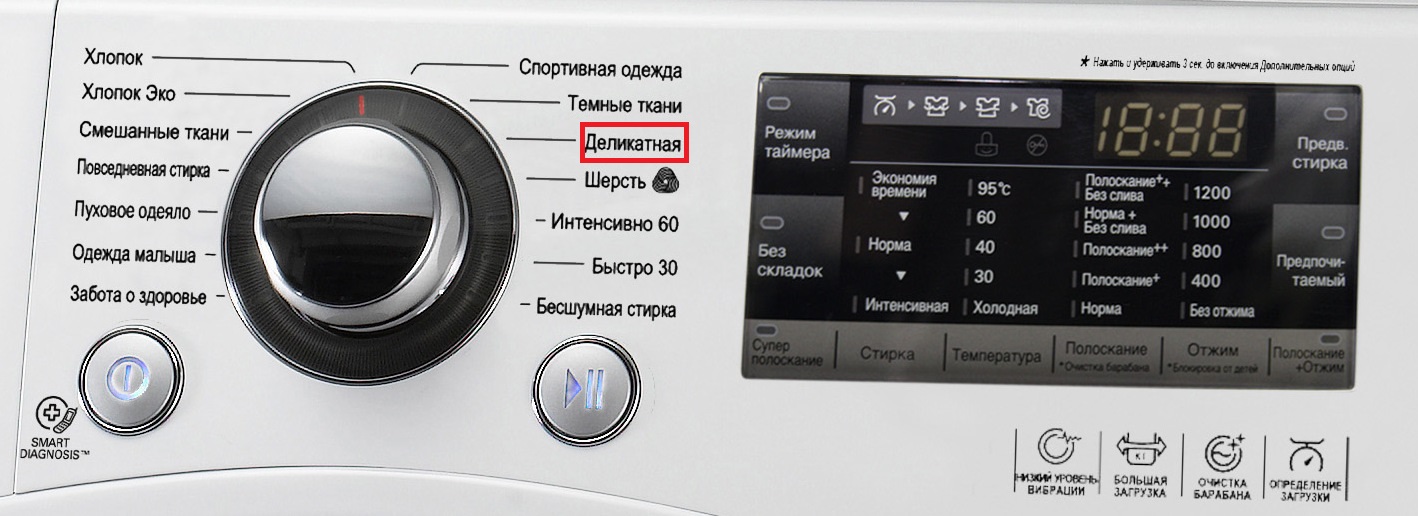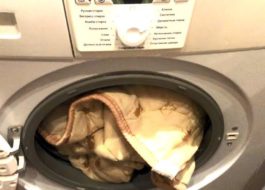How to wash a raincoat in a washing machine?
 How to wash a raincoat in an automatic washing machine without ruining it is a serious question and requires thorough analysis. Like other outerwear, such a cape is expensive and requires special care. Before putting an item into the drum, you should carefully examine the product label, prepare, select a detergent and set the optimal mode. All detailed instructions and tips from experienced housewives are given below.
How to wash a raincoat in an automatic washing machine without ruining it is a serious question and requires thorough analysis. Like other outerwear, such a cape is expensive and requires special care. Before putting an item into the drum, you should carefully examine the product label, prepare, select a detergent and set the optimal mode. All detailed instructions and tips from experienced housewives are given below.
Instructions for cleaning a raincoat in a machine
The first thing we always look at is the manufacturer's label. Washing parameters mainly depend on the material of the raincoat. Thus, lightweight fabrics such as cotton, linen and polyester are the most unpretentious and can withstand machine cleaning without any problems. It is strictly forbidden to load a leather or wool product into a drum, otherwise the item will be irrevocably damaged. The label will also show all the conditions for washing in a machine:
- delicate mode with a temperature of 30-40 degrees;
- refusal of automatic drying;
- minimal spin or turning it off.

After setting up the machine program, you can proceed to preparing the raincoat itself. It should be inspected, cleaned with a special roller, and if necessary, treat problem areas with a stain remover or soap solution. Don't forget to check all the rivets, fasten the zippers and turn the product inside out. Ideally, you need to place your outerwear in a protective mesh bag, or, at worst, in a pillowcase or duvet cover.
Spin and dry
Automatic spinning should not be used. Twisting is also prohibited, as thin fabrics quickly deform and lose their original shape.It is better to rinse the raincoat by hand by adding acetic acid or a delicate conditioner-rinse to the bath. Next, we lightly crush the material, let the water drain, and hang it on “hangers” right above the bathtub. Don’t forget to straighten the item, removing all dents and folds.
We complete natural drying in a ventilated room, on the balcony or outside. The main thing is that the washed item should not be exposed to direct sunlight. There is no need to remove the cape from the “hangers” - due to its vertical position, regular straightening and pulling, the cape will retain its original appearance.
If creases and wrinkles cannot be avoided, you can use a steam generator, steamer or a regular iron. But we remember the ironing rules: predominantly vertical position, temperature with a maximum of 100 degrees for polyester and 200 for linen and cotton. To reduce risks, iron only from the wrong side and through damp gauze.
Follow the basic rules
Before you start washing, it’s worth getting acquainted with a few basic rules for caring for raincoats. They are simple, but you must remember them.
- Raincoats made of natural silk, wool, viscose and nylon will not withstand a machine gun. They are only allowed to be hand washed and dried with towels in a horizontal position.
- Products made of leather, suede and with fur inserts are prohibited from being machine washed - only dry or dry cleaning is possible.
The information provided on the product label should not be ignored.
- You can't skimp on detergents. It is necessary to purchase delicate compounds without chlorine, aggressive chemicals and abrasives. The best choice would be soft gel-like textures designed specifically for the type of fabric you have.
- “Component elements” - belt, collar, hood, edge - are washed separately.
- Preliminary dry cleaning is required, as well as local removal of stains or dirt.
- The raincoat is washed separately from other items.
- Do not exceed the maximum temperature of 40 degrees.
- To avoid streaks, rinse the cape thoroughly, changing the water at least 3-4 times.
- Do not use artificial heat sources, batteries, heaters, or fans when drying. Contraindicated in delicate fabrics and direct ultraviolet radiation.
It is also important to monitor the washing process and make adjustments if necessary. So, if the cloak has lost its primary color after being in the machine’s drum, it is better to try to restore it. Mix two tablespoons of 9 percent vinegar with half a glass of water, moisten a sponge with the solution and gently wipe the material. For “prevention”, acetic acid is added immediately during rinsing - then the color becomes richer and brighter.
The nuances of cleaning raincoat fabric
Most often, raincoats are made from raincoat fabric, so we suggest taking a closer look at this material. This is a dense matte opaque fabric that can withstand not only manual but also automatic washing. But there are several nuances.
- Pay attention to the quality of coloring. If there are no suspicions, then we set the water heating to 40 degrees. For items with seemingly unreliable dyeing, the maximum temperature should be lowered to 25 degrees, otherwise the structure will delaminate and the color will wash out.
- Don't take unnecessary actions. Not only machine squeezing is prohibited, but also the most careful manual pressing. You should not wrinkle or rub the fabric, otherwise creases, folds and bruises will appear.It is enough to rinse the item and allow the water to flow freely from the fibers.
- Dry vertically and naturally. Here the standard requirements are repeated: we place the item in a well-ventilated room or outdoors, hang it on hangers and do not forget to straighten it.
We also pay close attention to ironing. As a rule, the manufacturer prohibits straightening fabric with a hot iron. But one-time exceptions are permissible, however, only steaming from the inside out at low temperatures.
Wash by hand
Although most raincoats can withstand tumble washing, it is better to give preference to hand cleaning. Working with your hands can reduce the risk of deformation of the material, especially when it comes to the most delicate fabrics. But you will have to put in much more effort and time. Raincoats are washed by hand as follows:
- water is drawn into the bath at 30-35 degrees;
- detergent is diluted in water;
- The item is immersed in the solution and rinsed lightly;
- the water is drained, and the raincoat remains at the bottom for 20-30 minutes;
- the bath is drawn, and vinegar or rinse aid is added to the water;
- the product is rinsed.
Rinsing is repeated several times to ensure complete leaching of the gel from the fabric fibers.
Drying takes place in an interesting way. The washed raincoat is wrapped in a terry towel and left to absorb moisture. Next, the base is changed to a dry one, after which the cape, spread out, lies on a drying rack or table in a well-ventilated room.
Cleaning from stains
Dry cleaning is considered the safest. At home it goes like this:
- grated soap is diluted in water;
- a sponge is dipped in the resulting solution;
- contaminated areas are treated;
- The raincoat is wiped with a clean damp sponge and dried.
Severe stains will require a solution of ammonia and vinegar. Also, talc, potato starch or salt are poured onto the stains. Leave the cleaner on the fabric for 1-2 hours, and then brush it off.
Interesting:
Reader comments
- Share your opinion - leave a comment
Categories
Washing machine repair


For buyers

For users

Dishwasher

















Add a comment